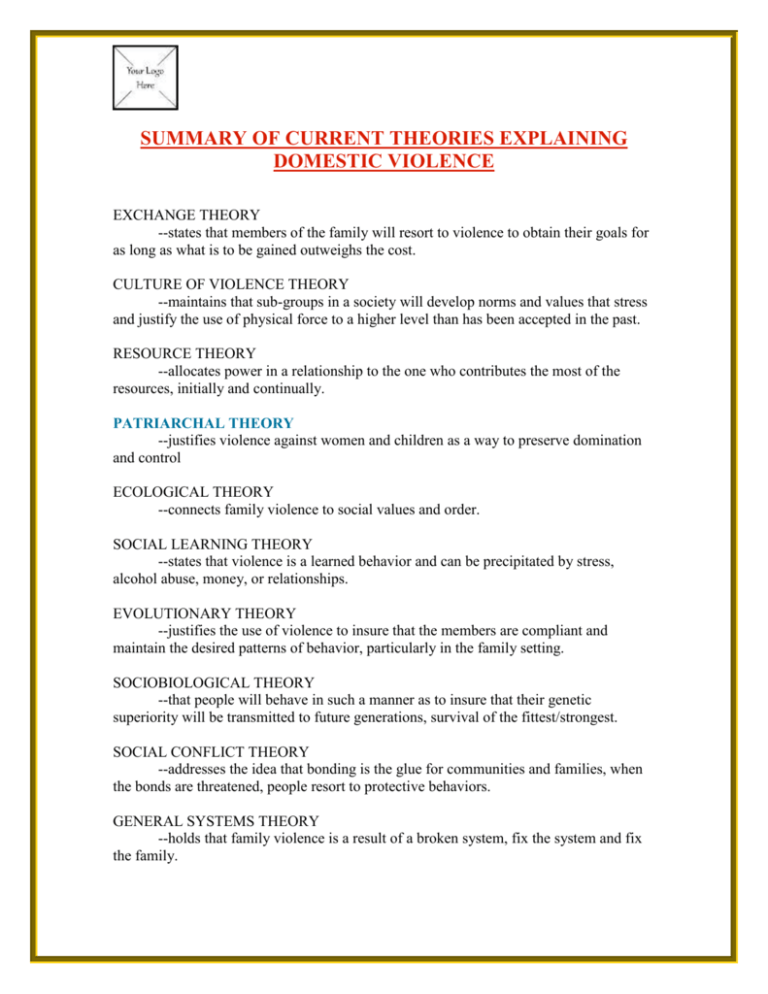summary of theories explaining domestic violence
advertisement

SUMMARY OF CURRENT THEORIES EXPLAINING DOMESTIC VIOLENCE EXCHANGE THEORY --states that members of the family will resort to violence to obtain their goals for as long as what is to be gained outweighs the cost. CULTURE OF VIOLENCE THEORY --maintains that sub-groups in a society will develop norms and values that stress and justify the use of physical force to a higher level than has been accepted in the past. RESOURCE THEORY --allocates power in a relationship to the one who contributes the most of the resources, initially and continually. PATRIARCHAL THEORY --justifies violence against women and children as a way to preserve domination and control ECOLOGICAL THEORY --connects family violence to social values and order. SOCIAL LEARNING THEORY --states that violence is a learned behavior and can be precipitated by stress, alcohol abuse, money, or relationships. EVOLUTIONARY THEORY --justifies the use of violence to insure that the members are compliant and maintain the desired patterns of behavior, particularly in the family setting. SOCIOBIOLOGICAL THEORY --that people will behave in such a manner as to insure that their genetic superiority will be transmitted to future generations, survival of the fittest/strongest. SOCIAL CONFLICT THEORY --addresses the idea that bonding is the glue for communities and families, when the bonds are threatened, people resort to protective behaviors. GENERAL SYSTEMS THEORY --holds that family violence is a result of a broken system, fix the system and fix the family. Current thinking is that the Patriarchal Theory is the dominant theory explaining the cause of domestic violence and sexual assault crimes. The behaviors of the offender are parallel to the brainwashing behaviors described by Biderman. Biderman, a German scientist, studied the patterns of brainwashing and developed the Scale of Coercion. The behaviors listed in the Scale of Coercion correspond to those listed in the Power and Control Wheel which is used to train domestic violence and sexual assault advocates. The Power and Control Wheel behaviors were gleaned from victim reports over a period of years. Biderman’s Scale of Coercion says there are essentially five steps to gaining control by one person over another: Omnipotence Threats of violence and violent attacks Isolation Emotional abuse Kindness The Power and Control Wheel, developed by the programs in Duluth, Minnesota from interviews with victims of domestic violence lists the following behaviors demonstrated by offenders towards victims: Using coercion and threats—making and carrying out threats to do something to hurt her, threatening to leave, to commit suicide, to report her to welfare, to gain custody of the children Using intimidation—destroying property and pets, displaying weapons, actions and gestures Using emotional abuse—name calling, mind games, humiliation and making her feel guilty Using isolation—controlling what she does and who she sees, acting out in front of family and friends, threatening relatives Minimizing, denying and blaming—making light of injury and abuse, denying harm, blaming her for the attacks Using children—threatening custody, complaints to child protective services, telling the children that she doesn’t care or that she has a boyfriend Using male privilege—insisting that he is head of household, making the decisions for all of the family members, controlling the activities of the family Using economic abuse—controls all of the money, pays all of the bills, goes with her shopping for groceries, clothing and personal items, gives her an allowance, requires receipts, takes money from her that she has saved.









